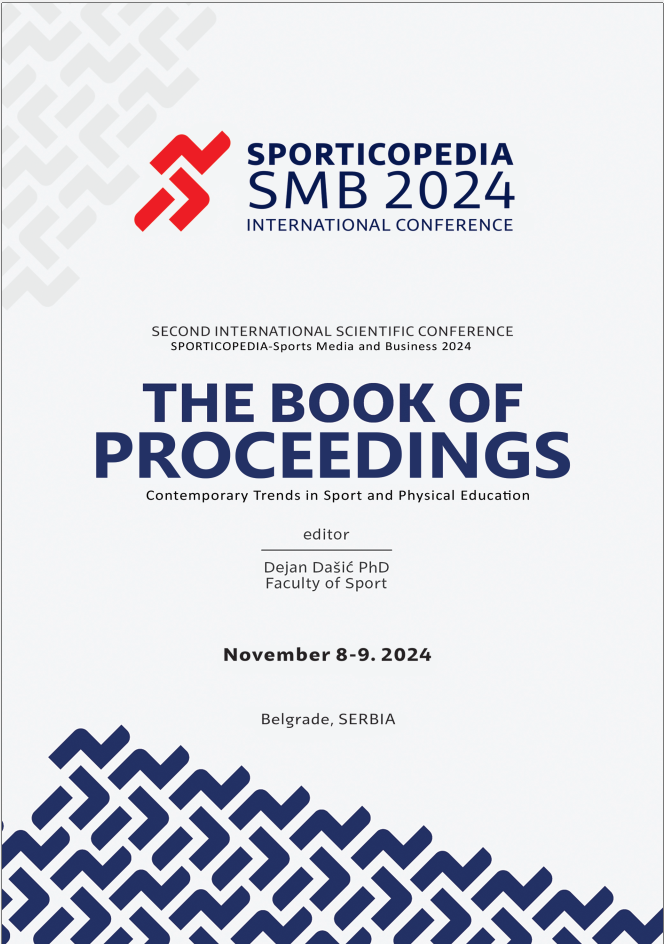Abstract
The ability of mass media to guide public attention has been known throughout history, and it has become much more important in the digital age when information is abundant. This era has also created many new opportunities for information distribution outside the traditional media, allowing media professionals and a wide spectrum of others to spread mass messages. All of this has impacted sports and physical activity, increasing the importance of media in this section of society in various ways. The purpose of this study was to see how different actors (parents, teachers, coaches) with varying daily routines (depending on their career) gather information regarding the value and impacts of physical activity, as well as whether it is important to them at all. The role of mass media is also assessed in disseminating information on these topics compared to other potential sources, such as conversations with friends, sports coaches, and doctors. The research was conducted in September 2022 as part of the „Promoting Green Strategies in Sport, ERASMUS Sport+“ initiative. It included participants from Serbia, Belgium, and Bulgaria. Based on the findings, it can be concluded that respondents primarily obtain information from socialnetworks, friends, and doctors, which can serve as a guideline for the future development of communication channels about the importance and effects of physical activity.
References
Bajić, P. (2020). Teorijski i praktični aspekti komunikacione teorije moći u globalnom umreženom društvu. Sport i biznis, br. 6, 19–25.
Bull, F. C., Al-Ansari, S. S., Biddle, S., Borodulin, K., Buman, M. P., Cardon, G., . . . Chou, R. (2020). World Health Organization 2020 guidelines on physical activity and sedentary behaviour. British journal of sports medicine, 54(24), 1451-1462. 3. Castells, M. (2009). Communication Power. Oxford University Press.
Centola, D. (2013). Social media and the science of health behavior. Circulation, 127(21), 2135-2144.
Chou, W. Y. S., Prestin, A., Lyons, C., & Wen, K. Y. (2013). Web 2.0 for health promotion: reviewing the current evidence. American journal of public health, 103(1), e9-e18.
Copić, Djordjevic-Nikic, M., Rakic, S., Markovic, M., Dopsaj, M., (2019). Relation between Lifestyle and Body Composition among Young Females in Serbia of 18–29 Years of Age. In Cardiorespiratory Fitness. IntechOpen.
Galani, C., & Schneider, H. (2007). Prevention and treatment of obesity with lifestyle interventions: review and meta-analysis. International journal of public health, 52, 348-359.
Grandić, R. B., Dedaj, M. D., & Panić, T. P. (2018). Parent’s attitudes towards physical education of preschool children. Inovacije u nastavi-časopis za savremenu nastavu, 31(2), 60-67.
Hu, F. B., Li, T. Y., Colditz, G. A., Willett, W. C., & Manson, J. E. (2003). Television watching and other sedentary behaviors in relation to risk of obesity and type 2 diabetes mellitus in women. Jama, 289(14), 1785-1791.
Laranjo, L., Arguel, A., Neves, A. L., Gallagher, A. M., Kaplan, R., Mortimer, N., … & Lau, A. Y. (2015). The influence of social networking sites on health behavior change: a systematic review and meta-analysis. Journal of the American Medical Informatics Association, 22(1), 243-256.
Lee, I. M., & Skerrett, P. J. (2001). Physical activity and all-cause mortality: what is the dose-response relation?. Medicine & science in sports & exercise, 33(6), S459-S471.
Li, J. S., Barnett, T. A., Goodman, E., Wasserman, R. C., & Kemper, A. R. (2013). Approaches to the prevention and management of childhood obesity: the role of social networks and the use of social media and related electronic technologies: a scientific statement from the American Heart Association. Circulation, 127(2), 260- 267.
Manovich, L. (2008). The Practice of Everyday (Media) Life. http://manovich.net/content/04-projects/059-the-practice-of-everyday-medialife/56_article_2008.pdf.
Miyashita, M., Burns, S. F., & Stensel, D. J. (2008). Accumulating short bouts of brisk walking reduces postprandial plasma triacylglycerol concentrations and resting blood pressure in healthy young men. The American journal of clinical nutrition, 88(5), 1225-1231.
Ostojić, S., Stojanović, M., Veljović, D., Stojanović, M. D., Međedović, B., & Ahmetović, Z. (2009). Fizička aktivnost i zdravlje. Tims Acta, 3(1), 1-13.
Petronijevic, S. (2023). Fitnes i zdravlje. Beograd: Fakultet za sport, Univerzitet “UNION Nikola Tesla”.
Potter, W. J. (2022). Media Literacy (10th Edition). SAGE.
Silveira, E. A., Mendonça, C. R., Delpino, F. M., Souza, G. V. E., de Souza Rosa, L. P., de Oliveira, C., & Noll, M. (2022). Sedentary behavior, physical inactivity, abdominal obesity and obesity in adults and older adults: A systematic review and meta-analysis. Clinical nutrition ESPEN, 50, 63-73.
Turow, J. (2019). Media Today: Mass Communication in a Converging World (7th edition). Routledge.
Young, S. D., Rivers, C., & Lewis, B. (2014). Methods of using real-time social media technologies for detection and remote monitoring of HIV outcomes. Preventive medicine, 63, 112-115.
Zhang, J., Brackbill, D., Yang, S., & Centola, D. (2015). Efficacy and causal mechanism of an online social media intervention to increase physical activity: Results of a randomized controlled trial. Preventive medicine reports, 2, 651-657.
Zhang, J., Brackbill, D., Yang, S., & Centola, D. (2015). Efficacy and causal mechanism of an online social media intervention to increase physical activity: Results of a randomized controlled trial. Preventive medicine reports, 2, 651-657.


